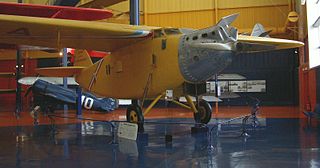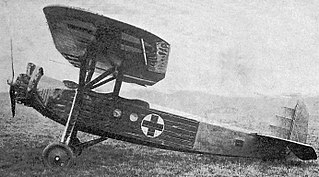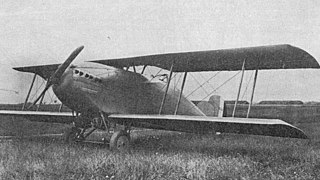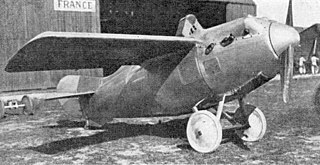Related Research Articles

The MB.210 and MB.211 were the successors of the French Bloch MB.200 bomber built by Societé des Avions Marcel Bloch in the 1930s and differed primarily in being low wing monoplanes rather than high wing monoplanes.

The Bernard 190 or Bernard-Hubert 190 was a French airliner of 1928. It was a high-wing cantilever monoplane of conventional configuration, based on the Bernard 18. Compared with its predecessor, it kept the same basic design but featured redesigned tail surfaces, an enlarged cabin, and offered its flight crew a completely enclosed cockpit. Also like its predecessor, the basic airliner model provided the basis for a long-range aircraft to be used in record attempts, the 191GR.

The Farman F.120 and its derivatives were a family of multi-engine airliners and bombers of the 1920s built by the Farman Aviation Works in France.

The Farman F.200 was a civil utility aircraft produced in France in the 1930s. Derived from the F.190, it featured a revised fuselage that did away with its predecessor's enclosed cabin. Instead, it was a parasol-wing monoplane with open cockpits in tandem for the pilot and one or two passengers. Intended primarily as a trainer, it was also marketed as being suitable as a photographic platform or a mail plane.

The Hanriot HD.14 was a military trainer aircraft produced in large numbers in France during the 1920s. It was a conventional, two-bay biplane with unstaggered wings of equal span. The pilot and instructor sat in tandem, open cockpits, and the fuselage was braced to the lower wing with short struts. The main units of the fixed tailskid undercarriage were divided, each unit carrying two wheels, and early production examples also had anti-noseover skids projecting forwards as well.

The Hanriot H.41 was a military trainer aircraft produced in France in the 1920s. It was a further development in the family of aircraft that had commenced with the HD.14 in 1920, and incorporated a number of design features that had been developed for other members of that family. Like those other aircraft, however, it was a conventional, two-bay biplane with unstaggered wings of equal span.

The Lorraine-Hanriot LH.10 was a family of training monoplanes built in France in the early 1930s, the most widely produced and well-known member of which was the LH.16, later known simply as the Hanriot H.16. It was a conventional parasol-wing monoplane with fixed tailskid undercarriage, the main units of which were mounted on outriggers attached to the wing struts. The pilot and instructor sat in tandem open cockpits.

The Hanriot H.43 was a military utility aircraft produced in France in the late 1920s and early 1930s which was primarily used by the Aéronautique Militaire as a trainer. While Hanriot had spent most of the 1920s manufacturing further and further developments of the HD.14 that had flown in 1920, the H.43 was an entirely new design. It was a conventional single-bay biplane with staggered wings of unequal span and a fuselage of fabric-covered metal tube. Accommodation for the pilot and passenger was in tandem, open cockpits and the main units of the fixed, tailskid undercarriage were linked by a cross-axle.

The Farman NC.470 was a French twin-engined floatplane designed as a crew trainer for the French Navy. It was used in small numbers for both its intended role as a trainer and as a coastal reconnaissance aircraft at the start of World War II.

The SPCA 30 was a French light bomber built by the Société Provençale de Constructions Aéronautiques (SPCA).

The Lorraine Hanriot LH.130 is a French racing aircraft designed and built in the early 1930s, to compete in the Coupe Michelin air races.

The Lorraine Hanriot LH.41 was a single-seat racing aircraft designed and built in France specifically to compete in the Coupe Michelin air races, held in France.

The Lorraine-Hanriot LH.70 or S.A.B. LH.70 was a French trimotor designed to a 1930 government programme for a colonial policing aircraft. Only two were built.

The Lorraine-Hanriot LH.21S was designed and built in 1930 to meet a French government requirement for a small air ambulance capable of operating in the colonies. It did not reach production.
The Latécoère 22 was a French mailplane built for Lignes Aériennes Latécoère in 1927.
The Hanriot H.33 was a French biplane 2-seat fighter aircraft built in 1926, derived from the Hanriot H.31. It was not successful and only one prototype was completed.
The Lorraine-Hanriot LH.60 was a training monoplane built in France in the early 1930s.

The Hanriot HD.24 was a two-seat colonial police biplane aircraft built by Hanriot in the early 1920s.

The Hanriot HD.22 was a racer aircraft built by Hanriot in the early 1920s.
The Hanriot HD.40S was a two-seat medical transport aircraft built in the 1920s, derived from the Hanriot HD.14S.
References
- ↑ Parmentier, Bruno (26 May 2003). "Lorraine Hanriot LH-30". Aviafrance (in French). Paris. Retrieved 7 February 2019.CS1 maint: discouraged parameter (link)